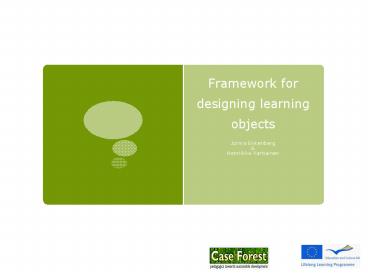Framework for designing learning objects PowerPoint PPT Presentation
1 / 9
Title: Framework for designing learning objects
1
Framework for designing learning objects
- Jorma Enkenberg
- Henriikka Vartiainen
2
LEARNING OBJECT our definition
As learning objects we mean digital
representations about real objects that represent
phenomenon in question and tools for constructing
meaning about it. Representations refer directly
or indirectly to real objects and context where
the objects are situated. Representations
allow perceiving the objects from different
perspectives. Physical and cognitive tools
enhance the negotiation of meaning about them.
3
Structure of learning object described in
activity theoretical framework
4
What are our challenges in Case Forest?
a) Development of digital representations about
real objects and their integration into design
resources for later use (model needed - described
in the following) b) Applying existing and
developed objects and other design resources for
studying and finding answers to formulated
question(earlier described Lusto method)
5
Model for developing digital objects
6
Descriptions of the used concepts
- REPRESENTATIONSVideos, pictures, drawings, text,
sound, map, animations and their combinations. - TOOLSPhysical (e.g. hammer) and cognitive tools
(e.g. tree structure) for the construction and in
use of learning object. - CASE STUDIESResearch reports (case studies), own
observations, measurements, interviews etc.
related to the phenomenon. - MODEL, SIMULATIONDifferent conceptual creations
e.g. scale models, diagrams, operation /action
models etc. - REAL OBJECTExisting physical artefact or object
in the nature, culture environment or elsewhere.
- SCAFFOLDS Social, conceptual and functional
assistance offered to support learning, e.g.
reflective questions and worked examples. - GUIDELINES Ideas how to use the object in
practice.AGENCY Description about social
setting and the roles during the activity. - INFORMATION RECOURSES Possible domain experts,
existing research data, literature, www-materials
etc. - GLOSSARY, TAGSLanguage / keywords that refers to
the phenomenon and objects. - DOMAIN PERSPECTIVESPoints of views and chosen
expert cultures to study phenomenon and object in
question.
7
RECOGNITION THE PHENOMENON The starting-point of
the learning process may be a visit to the
authentic environment and existing digital
resources that represents the environment. CHOOSI
NG THE DRIVING QUESTION RELATED TO THE
PHENOMENONCHOOSING THE REAL OBJECTS TO
STUDYObjects in the nature and culture
environment that mediate the phenomenon and
provide answers to the driving question.
DESIGNING THE STRUCTURE Choosing and
preliminary designing the digital representation
of the chosen object. REAL VISIT - COLLECTION OF
DATATaking photos, video clips, making
interviews, observations, measurements etc.
CHOOSING, ORGANIZATION AND INTEGRATION THE
COLLECTED DATA ABOUT REAL OBJECTSDESIGNING AND
IMPLEMENTATION THE SUPPORT FOR CONTEXTUALIZATION
Description of agency, guidelines, scaffolds,
information resources and glossary for
application of the developed learning object.
TECHNICAL INTEGRATION OF CONSTRUCTED DIGITAL
RESOURCES FOR THE LEARNING OBJECTIntegration to
the chosen environment (e.g. wiki).
8
Phases in the construction process
- Choosing the objects
- Preliminary analysis of the objects for
construction of the design for digital
representations - Collection design resources (in nature or museum)
- Organizing and elaboration design resources
- Contextualization
- Technical implementation
9
Examples of (research)learning objects
- Biologist perspective
- http//www.edu.joensuu.fi/kuvagalleriasokl/Kohteet
/album/Biologi/index.html - Engineers perspective
- http//www.edu.joensuu.fi/kuvagalleriasokl/Kohteet
/album/Insinoori/index.html - Economist perspective
- http//www.edu.joensuu.fi/kuvagalleriasokl/Kohteet
/album/Ekonomi/index.html - Antropologist perspective
- http//www.edu.joensuu.fi/kuvagalleriasokl/Kohteet
/album/Antropologi/index.html

